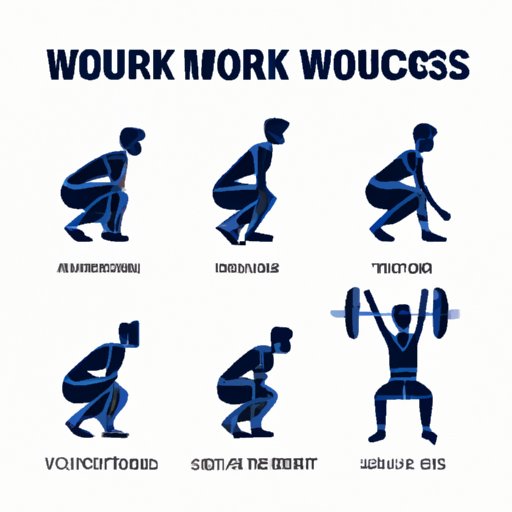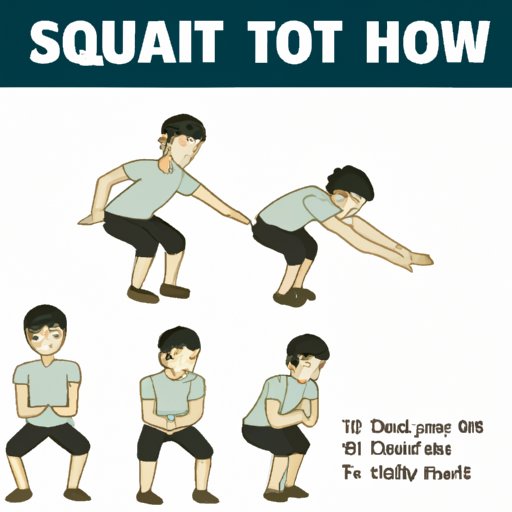Introduction
Squats are a fundamental exercise that should be included in every workout routine. Squats are beneficial because they target multiple muscle groups at once, including the quadriceps, hamstrings, and glutes. Squats also improve core strength, balance, and stability. Unfortunately, many people perform squats incorrectly, which can lead to injury and prevent them from gaining the full benefits of the exercise. This article will discuss how to squat properly, common mistakes to avoid, and different variations to keep your workouts interesting.
5 Common Squat Mistakes and How to Correct Them
There are five common mistakes that people make when performing squats:
- Leaning too far forward
- Knees caving in
- Failing to go low enough
- Round back
- Not engaging the core
To correct these mistakes, it is important to focus on proper form and technique. Leaning too far forward can be corrected by engaging the core and keeping the chest up. To prevent knee cave, make sure to push your knees outwards throughout the squat. Going low enough is a common problem among beginners, but it can be fixed by gradually increasing your flexibility and range of motion. A rounded back can be corrected by keeping your chest up and maintaining a straight spine. Finally, engaging the core throughout the squat will help to maintain proper form and stability.
The Ultimate Guide to Perfecting Your Squat Form
Proper form is crucial when performing squats. Incorrect form can lead to injury and prevent you from gaining the full benefits of the exercise. The proper squat form includes:
- Feet shoulder-width apart
- Toes pointed slightly outward
- Back and core engaged, chest up
- Hips pushed back, knees tracking over toes
- Depth dependent on individual flexibility and comfort
To perform a squat with proper form, step your feet shoulder-width apart and turn your toes slightly outward. Engage your core and keep your chest up. Push your hips back and bend at the knees, keeping them tracking over your toes. Lower yourself as far as is comfortable, and then press up through your heels to return to standing.
Build Stronger Glutes and Quads with These Top Squat Variations
Varying your squat routine can help target different muscle groups in the legs and glutes. Some of the most popular squat variations include:
- Front squats
- Sumo squats
- Box squats
- Bulgarian split squats
- Goblet squats
The front squat is performed with the weight in front of the body, while the sumo squat involves a wide stance with the toes turned outward. Box squats involve sitting back onto a box or bench before standing up again. Bulgarian split squats focus on one leg at a time, while goblet squats use a weight held at the chest to engage the upper body.
Tips for Beginners: How to Start Squatting Safely and Effectively
For beginners, it is essential to start with bodyweight squats before progressing to weighted exercises. It is also important to warm up properly before performing any exercise and to stretch afterwards to prevent injury and soreness. To start a bodyweight squat, stand with your feet shoulder-width apart and engage your core. Push your hips back and bend at the knees, keeping them tracking over your toes. Lower yourself until your thighs are parallel to the ground, and then push up through your heels to return to standing.
Squat vs. Deadlift: Understanding the Differences and Benefits
While squats and deadlifts are both excellent exercises that target the legs and glutes, there are some key differences between the two. Squats target the quadriceps, hamstrings, and glutes primarily, while deadlifts target the lower back and hamstrings. Squats are also a more functional exercise, as they mimic movements we perform in everyday life like sitting and standing. Deadlifts are best for building overall strength and can help improve posture and stability.

How to Incorporate Squats into Your Workout Routine for Maximum Results
Adding squats into your workout routine is easy and can be done with or without weights. Aim to do squats at least two to three times per week, starting with bodyweight squats and progressing to weighted exercises. Upper body weights can also be added to create a full body workout. It is important to listen to your body and take rest days as needed.
Conclusion
Squats are a fundamental exercise that target multiple muscle groups in the legs and glutes. It is important to perform squats with proper form to prevent injury and gain the full benefits of the exercise. Common mistakes can be corrected by focusing on form and technique, while varying your squat routine can target different muscle groups. Beginners should start with bodyweight squats and progress to weighted exercises, while incorporating squats into your workout routine can be done with or without weights. Remember to listen to your body and take rest days as needed.
